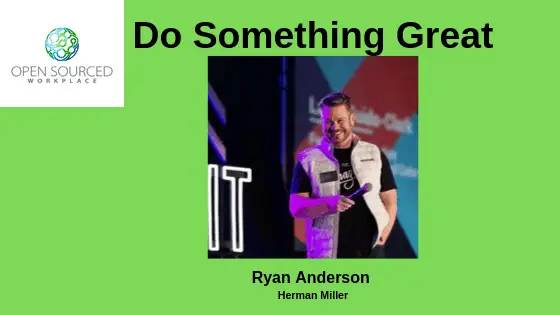There was one line of work that Ryan Anderson said that he would never get into: office furniture. Being from Grand Rapids, Michigan had provided him with a quarter of a lifetime of seeing the furniture industry from the outside and he truly thought nothing could be more boring. However, after his first year of college, Ryan found himself interning with Steelcase and discovering the industry that he would work in passionately for the next 25+ years.
Today, Ryan is working for Herman Miller, the large American-based furniture company. Ryan currently works with the technological side of office furniture. That statement might bring the question how are technology and furniture related? You’ll discover that workplace has a way of marrying a number of different factors, including how to do something great.
is working for Herman Miller, the large American-based furniture company. Ryan currently works with the technological side of office furniture. That statement might bring the question how are technology and furniture related? You’ll discover that workplace has a way of marrying a number of different factors, including how to do something great.
Do Something Great
Anderson’s passion for his work is clear in the way he discusses his “Do Something Great” mantra. It is a phrase that can cover a number of things, from work to personal life, but for Ryan, it is a few specific qualities. He explains that, to him, the short phrase means the following:
1. You have a limited amount of time to make an impact.
2. We all have the ability to make an impact, even if our job seems boring. It begins with how you treat the people around you.
3. Working to develop and design the workplace means realizing that the places that we help to design are where people spend a huge chunk of their lives. Getting it right means doing a good service.
Trying to do something great is an achievement that all people can strive for. Ryan explains that it takes 3-5 years to do something truly great. This means that it is important to focus and get things done. You might seem bored with the job or current project that you are working on, but you can do something great by being a good co-worker or boss. Or, you could be extra understanding or kind to clients. Being nice to others and working to give them a great space to spend at least 40 hours per week is a good way to “do something great.”
How Has Furniture Evolved Over Time?
When it comes to giving people great work spaces, you might start with getting a grasp on how furniture has evolved over time and how you might put that knowledge to use. Imagine an office in the pre-1970s era. Because of the lack of computers, employees were not tied to a desk. With the use of notebooks, workers used a variety of spaces to complete their tasks.
The 80s and 90s brought the use of the desktop computer and thus, cubicles. Because of the way computers were used, employees stayed in their cubicles for the majority of the day. This left little need for other kinds of spaces in an office building. However, the cubicle era created the need for a computer, phone, desk, and chair for every single employee. It was because of this that the industry boomed during that time.
We are now no longer required to work from a desk all day every day. Modern technology means that workers can work in various spaces again – there is no need to sit at a desk for 8+ hours. This does mean, however, that the industry has to find new ways to make sales, since a full desk, chair, phone, and computer is no longer necessary. With this being a huge change in the workplace, research is necessary to keep business thriving.
Researching in the Office Furniture Industry
Serving organizations properly with all of the changes and trends in the modern world requires research. Scenario planning is one of Ryan’s favorite methods. It starts with asking people what they might expect out of the future or their reactions to futuristic movies. From those expectations come stories. Those stories help people in the industry to see what might become of the future workplace.
Herman Miller also utilizes a network of research collaborators that they work with. This includes researching with others and also ethnographic research. This means that Ryan and those in his career-path watch people work, interview them, and bring along people trained in pattern language.
With an open mind and plenty of research, Herman Miller and similar companies stay relevant in the ever-changing world. Herman Miller has done a great job of understanding the global trends by getting into areas that lead the way.
Real Estate and Technology
Both real estate and technology have a huge impact on how people work and neither seems to completely grasp how much. If you think about it, real estate is required for any workplace. Technology is and required. The two have the ability to merge and work together, but still do not reach their full potential.
On the other hand, the two groups can unintentionally pull usage from one another. It is necessary that organizations find the best way to inform each aspect of their company of the ways in which they might collaborate.
Because of Ryan’s brief departure from furniture and technology within the furniture industry into a software startup with Teem, he has an interesting understanding of the topic and brought it back to Herman Miller. Technology is imperative within an organization. Real estate is also important.
Software has overtaken hardware. Will the same occur in real estate and technology if the two are not used collaboratively? The digital seems to be on the rise while the physical is less prominent. However, Ryan claims that introductions between the two ends is the best course of action to keep both on the map.
Collaboration in the Modern World
The idea of collaboration has always been working with someone else in the same physical place. With modern technology, however, that is no longer necessary. While that is a fact, there is still a need for private space to collaborate. In the next 5 to 10 years, Ryan expects technology in the form of augmented reality to be a collaboration tool used commonly.
Augmented reality differs from virtual reality because there is no need for a headset. Rather, augmented reality projects images into your environment, like with PokemonGo. This is something that will be a huge change in the workplace and the furniture industry is already readying themselves for the change.
because there is no need for a headset. Rather, augmented reality projects images into your environment, like with PokemonGo. This is something that will be a huge change in the workplace and the furniture industry is already readying themselves for the change.
Learning about these future technological changes allows for the best productivity for years to come. You will not have to play catch up once those technologies are made available. It is important to discuss those changes with your team’s as well in order to prepare everyone for the future of workplace.
While this might influence some expectations of the workplace, it can also ready them for those expectations to be met. Additionally, it can tell organizations what their employees are expecting of them. That knowledge allows companies the opportunity to enhance employee experience.
Anderson’s knowledge surrounding office furniture, technology, and real estate is vast and can provide a lot of insight. Perhaps most important, however, is that he seeks to do something great.
Ryan Anderson is VP of Digital Innovation at Herman Miller – watch the interview here
Check out other OSW Topics – Coworking , Technology
, Technology , Stress
, Stress , Wellness
, Wellness , Sustainability
, Sustainability , Workplace Productivity
, Workplace Productivity , Employee Experience
, Employee Experience , Hot Desking
, Hot Desking
Related Questions
What is Teem? Teem was a startup purchased by WeWork that aims to develop a productive, efficient, and creative workplace by connecting people, places, and technology.
What other forms of collaborative software exist? Some of the most popular collaboration technology includes Google Suite, Zoom , Slack, and Microsoft Teams are just a few of the available options for collaborating with others in another space.
, Slack, and Microsoft Teams are just a few of the available options for collaborating with others in another space.


